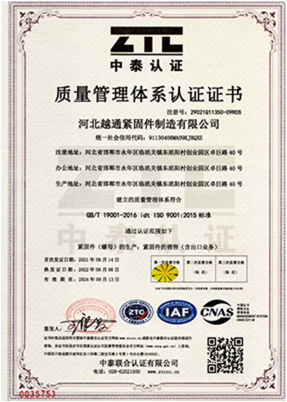Lis . 29, 2024 11:15 Back to list
Understanding Metric Sizes for Hex Nuts and Their Applications in Fastening Solutions
Understanding Hex Nut Sizes in Metric System
Hex nuts are essential components in fastening applications, providing a secure connection between bolts and the materials they attach. These six-sided fasteners come in various sizes and materials, making them versatile in different environments and applications. When working with hex nuts, understanding their sizing—especially in the metric system—is critical for ensuring that fasteners fit perfectly and perform reliably.
Definitions and Measurements
The size of a hex nut is typically defined by its width across flats (WAF), which is the distance measured from one flat side of the nut to the opposite flat side. Additionally, the size classification can be determined by the thread pitch and diameter of the corresponding bolt. For instance, a common metric measurement for a hex nut might be M8, which indicates that the nut is designed to fit a bolt with an 8mm diameter.
The thread pitch, the distance between threads measured in millimeters, can significantly impact the performance of a fastening application. For example, an M8 hex nut may come in various thread pitches such as 1.25mm (standard) or 1.0mm (fine). It is crucial to ensure that the hex nut and the bolt have matching thread specifications to achieve optimal fastening.
Common Sizes and Specifications
In the metric system, hex nuts are available in various standard sizes, with some of the most common being M6, M8, M10, M12, M16, and M20. These designations refer to the diameter of the bolt that the nut is designed to fit. The corresponding widths across flats will differ for each size, allowing for quick identification and selection.
hex nut sizes metric

- M6 Hex Nut Typically has a WAF of 10mm. - M8 Hex Nut Usually has a WAF of 13mm. - M10 Hex Nut Generally features a WAF of 17mm. - M12 Hex Nut Normally has a WAF of 19mm.
These dimensions may vary slightly depending on the country of production and the specific standards that are adhered to, such as ISO or DIN norms.
Materials and Finishes
Hex nuts can be made from a variety of materials, including steel, stainless steel, brass, and nylon. Steel nuts are often treated with coatings such as zinc plating or black oxide to enhance corrosion resistance. Stainless steel hex nuts offer exceptional durability and are suitable for environments exposed to moisture or corrosive substances. On the other hand, nylon nuts provide lightweight and non-metallic options, often used in applications where electrical insulation is necessary.
Applications in Various Industries
Hex nuts find their applications across various industries, including construction, automotive, marine, and manufacturing. Their strength and reliability make them ideal for structural connections, machinery assembly, and automotive components. In construction, for example, hex nuts are essential for securing beams and panels, ensuring structural integrity.
In summary, understanding hex nut sizes in the metric system is fundamental for anyone working with fasteners. By knowing the specifications, common sizes, and materials used, users can ensure they select the correct nut for their projects, thereby enhancing the overall quality and safety of the assembly. Whether you are a professional tradesperson or a DIY enthusiast, mastering hex nut sizes will significantly improve your ability to tackle fastening tasks effectively.
-
sleeve-anchor-innovations-that-hebei-yuetong-fasteners-engineering-excellence
NewsAug.22,2025
-
screw-s-precision-engineering-for-global-industries
NewsAug.22,2025
-
hexagon-nut-that-high-quality-fasteners-from-hebei-yuetong
NewsAug.22,2025
-
clamp-that-high-quality-fastening-solutions-from-hebei-yuetong
NewsAug.22,2025
-
bolt-that-reliable-fasteners-from-hebei-yuetong
NewsAug.22,2025
-
anchor-bolt-that-premium-fasteners-for-secure-and-durable-installations
NewsAug.22,2025


